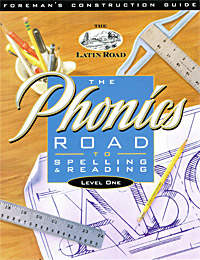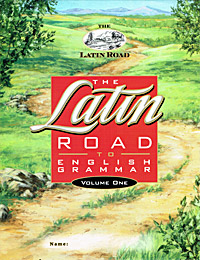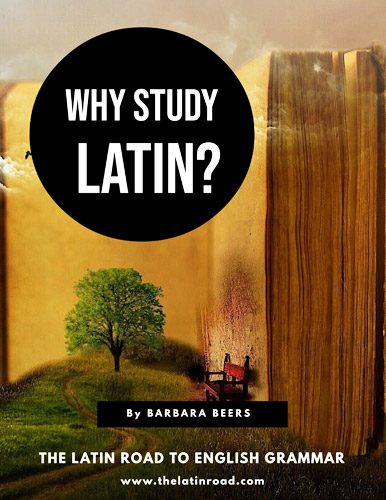Why Study Latin?
The most common reaction to the subject of Latin in today's world usually begins with a loud groan followed by a few remarks about how irrelevant that dead language is to today's modern students. But those remarks tend to show how unenlightened those educators and students are because they don't even realize that Latin is a language which has been the most widely used in all the world's history.
So why study Latin? First and foremost, there is no other language in the world that affects English as much as Latin; our vocabulary is over 60% Latin-based, supplying us with our more sophisticated and technical words. Because Latin words form the basis for thousands of English words, a student can increase his word power faster and more efficiently, not only gaining clues to meanings, but also clues to spelling — yes, spelling!
An important reason that English spelling remains a mystery to most children and adults alike is that no one teaches them that Modern English incorporates two subtly different styles of spelling. This results from the way in which Modern English became a written language.
Most of the borrowed Latin words were connected to cities, government, art, law, science, philosophy, business, and the military. But the words of home, childhood, farm, forest, and seas, continued to be the native English words. These had come down to us from Old High German through half a dozen Old English dialects. For these words a whole new spelling system was invented with spelling patterns, which differ from those of Latin words.
If we compare some of our Germanic words with those of like meaning, which come to us from Latin, we can notice that the every-day words are commonly from the German; and the more ornamental ones are from the Latin. For example, we get the word water straight from the German, but when we speak of aquatics, we are using a Latin base. We know that the word house comes from the German, but the related word domicile is formed from a Latin base. The same comparisons can be seen in like and similar, many and numerous, almighty and omnipotent, heavenly and celestial, truth and veracity, happiness and felicity. The first of each of these pairs is the more common word of our German roots, and the second word of each pair is a more sophisticated use of the word from our Latin roots.
We thus have two different styles of spelling in Modern English, the native English style which applies to words of German origin, and the Latin style which applies to words which came down to us directly from Latin or by way of its daughter languages, French and Italian. Each style has its own set of characteristics and principles that need to be taught if we want to give our students a complete understanding of English and languages in general.
You and your students need to know... the rest of the story! The native English style of spelling affects all of our one-syllable words regardless of origin. It also affects the vast majority of the two-syllable words, which occur in early primary materials. This is the style of spelling that we study in the first two levels of The PHONICS Road to Spelling and Reading. Beginning in Level Three and continuing through Level Four of The PHONICS Road, students encounter words affected by the Latin style of spelling. At this point in the study we begin to record in detail the exact differences in the two styles. The Latin style of spelling introduced in these levels is fully developed in The LATIN Road to English Grammar as the teacher and student study and translate Latin while fine-tuning their advanced English grammar skills. So you can see that these are the only curricula that fully develop the skills of spelling, writing, reading, grammar, and Latin from K/1 through junior high school years.
Because Latin is the mother language of Spanish, French, Italian, Portuguese, and Rumanian, a student also receives a good working introduction to these languages by studying Latin. Importantly, we learn as we translate that Latin and English represent two different language structures. Latin is a highly inflected language, showing functions of words by adding endings to base words. English is by and large a non-inflected language, showing functions of words not by changing the words but by where they are placed in the sentence in relationship to the other words. By comparing and contrasting these two languages for three years through translating back and forth between Latin and English, a student understands not only the details of both languages well but how most of the languages of the world work. That is why Latin students have the ability to pick up other languages so quickly and are so comfortable with English that they score high on all standardized tests.
We see the Latin language reflected in the areas of history, literature, science, and law, giving us clues to our calendar, state and national mottoes, law terms, science vocabularies, the Roman Republic and Roman Empire, the Bible, and hundreds of years of historical and literary documents. In the words of author Dorothy Sayers, "...even a rudimentary knowledge of Latin cuts down the labor and pains of learning almost any other subject by at least 50%."
Because of all these factors, Latin makes the best first foreign language to learn and teach. The fact that no one speaks Latin today is the reason some people consider it dead. And yet I consider that fact the biggest plus for teaching it. With Latin I do not have to be burdened with teaching aimless conversations and can spend my time teaching the structure and vocabulary of the language and integrating Latin with English through the translation process.
So now that you have a reason and desire to learn Latin, how do you go about learning a language that you have never experienced before? You are the very reason that I wrote The LATIN Road to English Grammar, a complete Latin language study designed for parents and teachers who do not know Latin. This unique program gives you the ability to learn and teach Latin at the same time; with my help, you and your students learn together. All the preparation work has been done for you, and a full English grammar course has been built into the study so you are actually teaching four subjects at once in about an hour a day: Latin, English grammar, vocabulary, and advanced spelling. This three-year study is the equivalent of two years of high school Latin, which can be started with students as early as 5th/6th grade. For those students a bit younger or those weak in English grammar, I invite you to consider The BRIDGE to the Latin Road, my one-year introduction to The LATIN Road to English Grammar.











